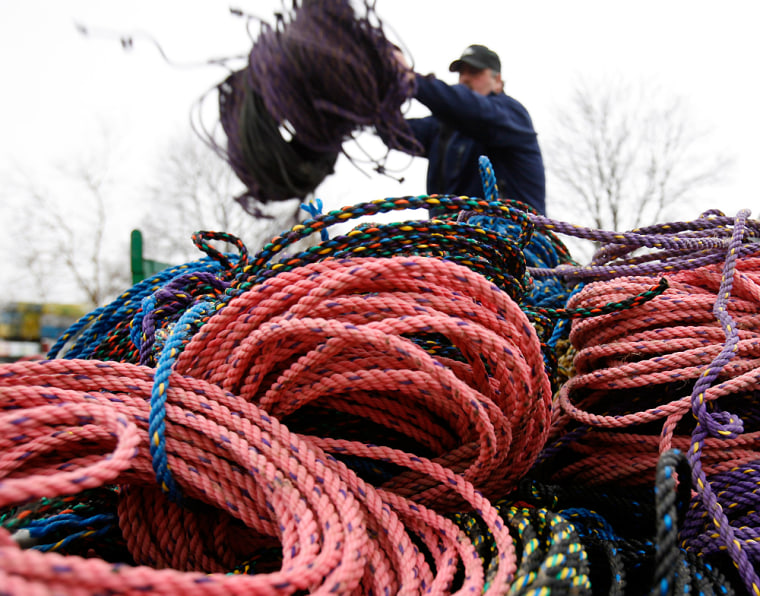Frank Thompson was among the scores of unhappy lobstermen who delivered millions of feet of rope to a warehouse in this fishing community.
He said the fishing rope piled high in his pickup truck and trailer was still good, except for one thing: Come Sunday, it will be illegal.
A new federal regulation, years in the works, outlaws the use of floating rope that connects millions of lobster traps on the ocean bottom and sometimes entangles endangered North Atlantic right whales.
Marine scientists and conservationists say using rope that sinks will make the whales less prone to getting snagged as they lumber through the Gulf of Maine each spring and summer.
Lobstermen such as Thompson, who lives on the island of Vinalhaven, say the rule will increase costs and do little, if anything, to help whales. They claim the regulation is overkill and could make lobstermen as endangered as the whales.
"They're slowly driving us out of the lobster business, aren't they?" a grim-faced Thompson said last week.
Whale advocates maintain the rule is a vital tool to protect right whales. Five cases have been documented in recent years of the whales getting tangled in gear set by Maine lobstermen, said Vicki Cornish, of the Washington, D.C.-based Ocean Conservancy group.
"They're always at risk because there are such low numbers," Cornish said.
Only 300 to 400 whales remain
The North Atlantic right whale was severely overharvested through the 19th century by aboriginal and commercial whalers who found them easy targets because they're slow swimmers and their high fat content makes them float after they die. There are now an estimated 300 to 400.
The whales, which are about 50 feet long and weigh up to 70 tons as adults, live along the Eastern seaboard. They migrate each year between breeding grounds off Florida and Georgia to summer feeding grounds off New England and the Canadian Maritimes.
They've long been protected from commercial whaling, but they still face threats from ship collisions and fishing gear entanglements.
To protect them, the National Oceanic and Atmospheric Administration set speed limits for ships 65 feet or longer in areas where they breed, feed and migrate.
Last fall, East Coast fishermen who use certain types of nets were required to use sinking rope to reduce entanglements. On Sunday, thousands of lobstermen and other trap fishermen from Maine to the Southeast have to do the same.
Nowhere will the impact be greater than in Maine, home to nearly 6,000 licensed lobstermen and an estimated 3 million traps.
Lobsters are caught in traps strung together on the ocean bottom and attached to buoys on each end. When floating lines are used to connect the traps, they form arcs of rope that can entangle whales. Sinking rope avoids that problem.
In preparation for the new rule, lobstermen have been getting rid of tens of millions of feet of floating rope and replacing it with sinking rope as they get ready to set their traps in the cold ocean waters in the coming weeks for the lobster season.
Government grants that are available to buy back the old rope have cushioned the financial blow. But fishermen say they'll still have to spend thousands of dollars each on the new rope. And they say the timing couldn't be worse: When the economy melted down last fall, lobster prices fell to levels not seen in decades, putting lobstermen on shaky financial footing.
‘We’re paying the price’
Fishermen say the sinking rope is more expensive than floating rope and won't last as long because it sits on the ocean bottom, where it scrapes and snags on rocks. And because the rope is prone to break, lobstermen say they'll lose traps.
Thompson said he was unimpressed with the sinking rope after experimenting with it over the winter while fishing 50 miles offshore.
He said he can't help being frustrated: He's never seen a right whale in his 43 years on the water, but he'll have to spend more than $40,000 on new rope for traps fished from his two boats.
"We have not endangered the whale," he said, "but we're paying the price."
Supporters of the new rule say there's no denying the statistics. Between 2002 and 2006, the National Marine Fisheries Service confirmed 25 gear entanglements and 15 ship collisions involving right whales along the Eastern seaboard.
This past winter, marine officials said they found off the Georgia and Florida coasts five entangled right whales, one of which was caught in lobster gear from Canadian waters.
The Ocean Conservancy's Cornish said whales encounter a spider web of lines off Maine created by the traps. The rules already give Maine lobstermen a break by exempting large portions of the ocean close to shore, and if anything, they should be stronger, she said.
"I'm not jumping up and down with joy, because I think (the fisheries service) missed the ball on where the sinking-line requirements should apply," Cornish said. "The whales that got entangled in Maine state waters are still at risk from floating lines in those exact same areas."
